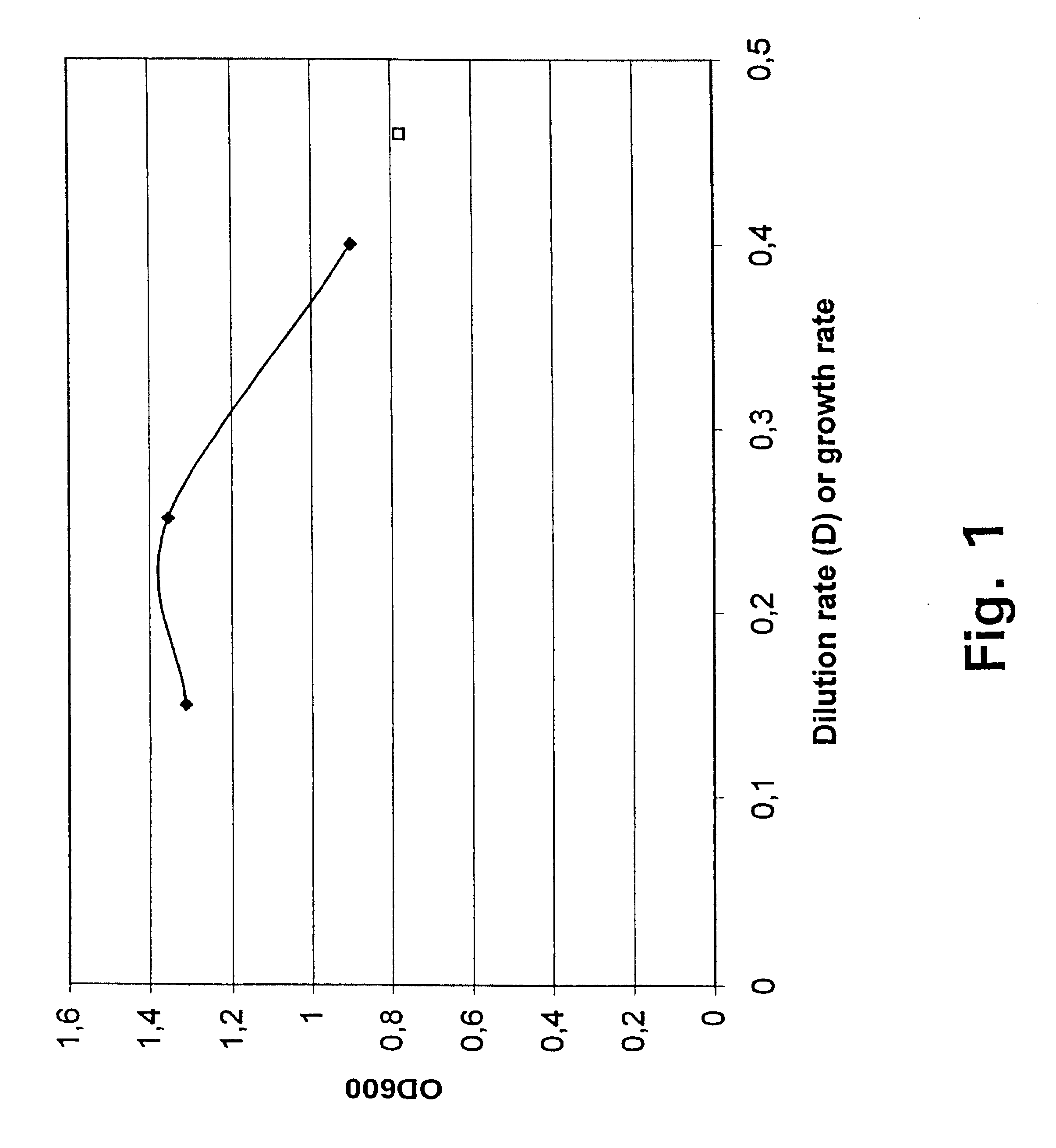Method of improving biomass yield of lactic acid bacterial cultures
a technology of lactic acid bacteria and biomass yield, which is applied in the field of improving the biomass yield of can solve the problems of reducing the shelf life of commercial starter culture products made from the thus produced lactic acid bacterial cultures, reducing the yield of biomass generally relatively low, and reducing the yield of viable cells
- Summary
- Abstract
- Description
- Claims
- Application Information
AI Technical Summary
Benefits of technology
Problems solved by technology
Method used
Image
Examples
example 1
Activation of ATP synthesis in Lactococcus lactis cultivated in the presence of selected sugars
Various strategies can be applied to activate ATP synthesis by the H.sup.+ -ATPase / ATP synthase complex. One such strategy is to obtain a low ATP / ADP ratio by selecting particular sugar substrates. Some sugars are metabolised readily whereas others are "exotic" to lactic acid bacteria and are for that reason more slowly metabolised. Therefore, by changing the sugar substrate in the growth medium the rate of ATP synthesis can be varied, which can then be exploited to modulate the ATP / ADP ratio in the growing cells.
1.1 Cultivation of Lactococcus lactis subsp. cremoris in a medium containing glucose as the sole carbon source
Wild type L. lactis subsp. cremoris PJ4662, a derivative of the strain MG1363 containing the pAK80 plasmid (Israelsen et al., 1995) was grown aerobically in defined SA medium (Jensen and Hammer, 1993) supplemented with a growth limiting concentration of glucose (GSA), and ...
example 2
Activation of ATP synthesis in Lactococcus lactis cultivated under conditions optimised for high biomass production in the presence of either maltose or lactose
The experiments presented in Example 1 were all performed in relatively diluted cell cultures and served to demonstrate the principle of activating ATP synthesis in lactic acid bacteria. However, in many cases where lactic acid bacteria are used for industrial purposes the biomass in the fermenters are much more concentrated. To demonstrate that the principle of activation of ATP synthesis also works for such cultures an experiment in media optimised for high biomass production was performed.
2.1 Materials and methods
A commercial mixed strain starter culture of Lactococcus lactis was applied in this Example. The cultivations were performed on complex media containing hydrolysed skimmed milk powder, yeast extract, essential vitamins and minerals and either lactose or maltose as carbon source. Furthermore, the media were supplem...
example 3
Effect of a porphyrin compound on the intracellular ratio [ATP] / [ADP] in Lactococcus lactis cultivated in the presence of a slow fermentable carbon / energy source
The idea behind the present invention is that growing the cells on a slowly fermented carbon / energy source results in a low cellular energy state (as reflected in the intracellular [ATP] / [ADP] ratio). The low energy state causes subsequently the ATP synthase to work in the ATP synthesis direction resulting in ATP production opposite direction compared to normal and produces ATP which is then reflected in a faster growth and a more efficient conversion of sugar into biomass as presented in the Examples above.
The intracellular concentrations of ATP and ADP was measured to test whether the addition of a porphyrin to a culture growing on a poor carbon / energy source would increase the [ATP] / [ADP] ratio as might be expected if the ATP synthase starts to produce ATP.
3.1 Material and methods
Samples were taken from exponentially grow...
PUM
| Property | Measurement | Unit |
|---|---|---|
| diameter | aaaaa | aaaaa |
| dry weight | aaaaa | aaaaa |
| pH | aaaaa | aaaaa |
Abstract
Description
Claims
Application Information
 Login to View More
Login to View More - R&D
- Intellectual Property
- Life Sciences
- Materials
- Tech Scout
- Unparalleled Data Quality
- Higher Quality Content
- 60% Fewer Hallucinations
Browse by: Latest US Patents, China's latest patents, Technical Efficacy Thesaurus, Application Domain, Technology Topic, Popular Technical Reports.
© 2025 PatSnap. All rights reserved.Legal|Privacy policy|Modern Slavery Act Transparency Statement|Sitemap|About US| Contact US: help@patsnap.com


